Farmer John Writes: The Heavens Beckon and The Earth Dictates
Harvest Week 18, Deliveries of October 17th – 21st, 2023
The Crops
Lots of crops still to put in your boxes—bounty galore.
Brussels sprouts—they got nipped by frost, not as deep a frost as I would have liked for sweetening them, but we have so many Brussels sprouts, we need to start giving them. I like giving them attached to the stalks; they are more dramatic that way. You might notice some blackish wrappers on some of the sprouts; generally, you can just peel those off to get to the green sprout you want. We don’t bother to clean the sprouts thoroughly. It takes way too much time for our crew, and this lets you become farm helpers from afar.
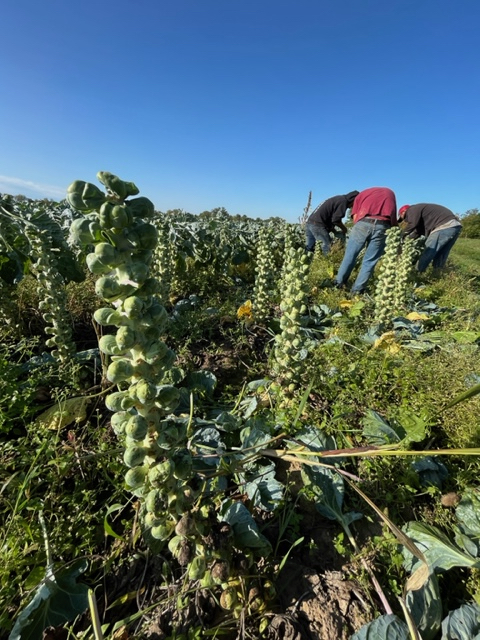
best crop of Brussels sprouts in years
Broccoli—we lost a lot of broccoli because it headed out in the recent warm weather; it didn’t actually head out—it bolted. We ran out of broccoli last week during the pack, and replaced the missing broccoli with beautiful cabbage. No broccoli this week; hopefully some later.
Carrots—If you ordered them, you will be receiving some of our long carrots that I wrote about in the last issue of Farm News, Is it a Trade? A Craft? An Art? (For those of you who didn’t receive a box or a newsletter last week, I suggest that you take a look at that issue. I am realizing that, in general, shareholders should receive every issue of Farm News, even if they are every-other-week shareholders. The communication in each issue is important, and provides a continuum of news about your farm. Next year, we’ll make that happen.) Back to these long carrots, you can impress your friends by claiming that satellite positioning helped them to be long.
Nightshades—We finally ended our peppers, eggplant and tomatoes, like striking a stage set, back to undifferentiated expanses of fields. We still have peppers for at least some of you this week. Weird to have peppers still. The people grading them last week applied peak season quality standards to the peppers and tomatoes. I intervened, saying, “Even if these peppers and tomatoes have a slight flaw, give them. Mid-October peppers are a rare treasure up here in northern Illinois. Let’s share the treasures.”
Celeriac, Kohlrabi, Bok Choy—harvested before the storms last Friday.
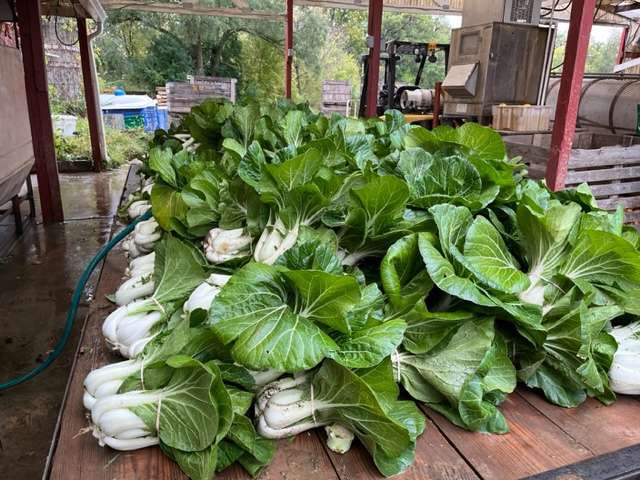
bok choy, first in line for a wash
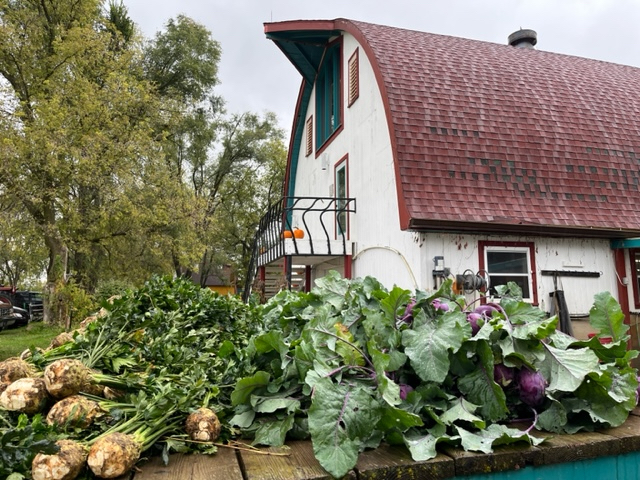
celeriac and kohlrabi await their turn for a wash
Potatoes are free of the threat of mud and are now in storage.
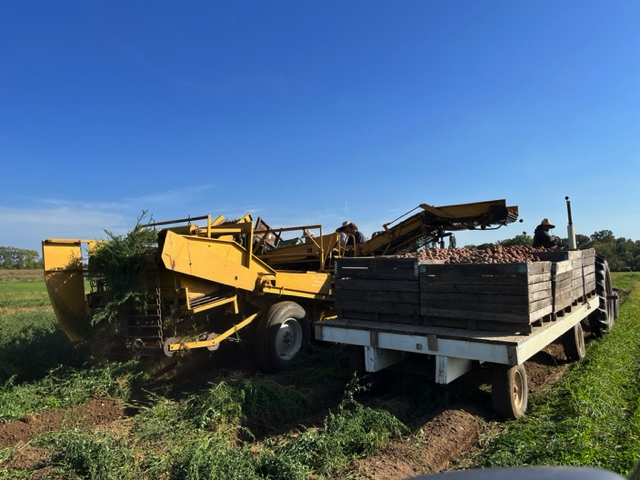
dry ground and potato harvest belong together
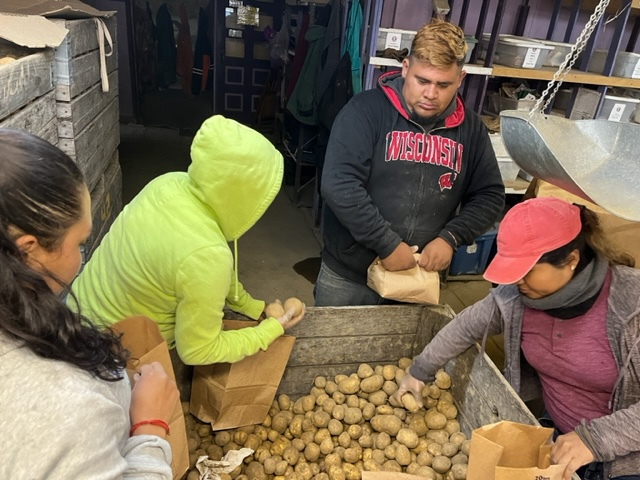
bagging potatoes inside when it’s cold and wet outside
The Weather
We scrambled at the end of last week and the beginning of this week, covering crops against frost, and bringing in frost sensitive squash by the thousands. With only a nip of frost last Monday night, the weather turned warm again, and rainy. As I am sure you realize, we don’t try to outguess the frost; when frost threatens, we farm accordingly. Then it freezes or it doesn’t. Same with rain; if rain is likely, we treat it as a given.

covering baby lettuce
The Pack
Many volunteers faithfully come to help us pack boxes week after week, usually between 14 and 20 volunteers. We need 21 people on the pack line, so we are blessed to only have to use half of our crew to supplement the pack line—often less than half. That way, our crew can get other things done during the pack. Getting things done on time is our over-arching goal here.
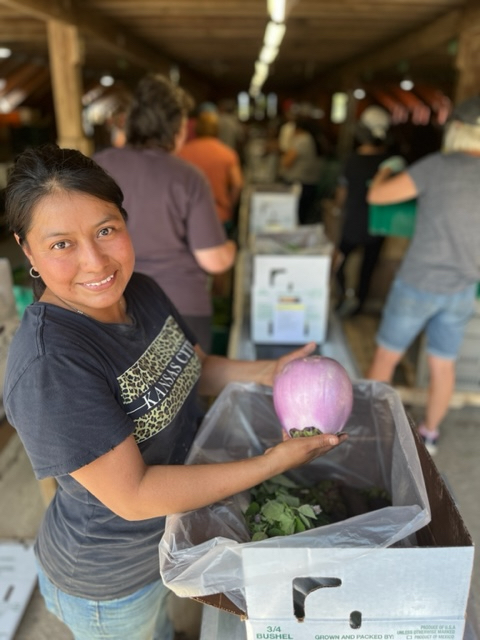
Concepcion smiles like the sun
The number of items we offer for the pack has mushroomed to 14 or 15, from 12 or 13 earlier. We don’t have room to line up more than 15 items on the pack line, and that many is a stretch.
The Crew
The crew is fun, fast, and hard working.
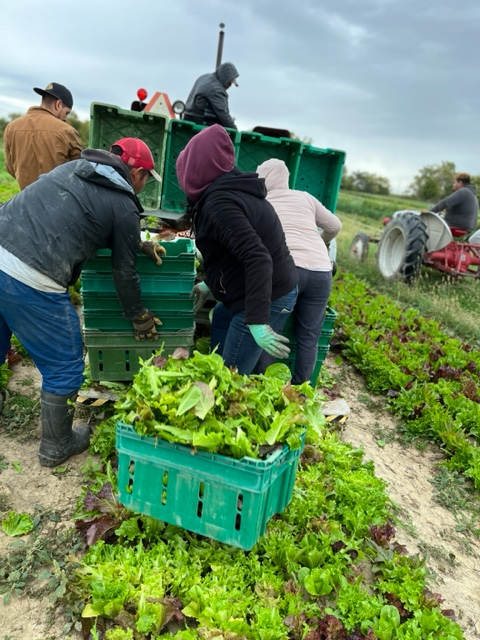
the crew harvests lettuce mix
Last week, everyone hustled even more than usual, and the crew was able to take off last Saturday morning—first free Saturday morning all season.
Managing the Farm
Every year, I feel that I gain more competency and wisdom managing the farm. I often think, “wow, I have learned so much this year. I don’t know how I was able to pull all this off in prior years.” I have been running the CSA for 34 years, and I typically feel that I am barely getting good enough to do it. Is this self-deprecation? Misguided humility?
I think of managing the farm as a bit like creating a painting (or another art form). The paint goes onto the canvas, and then the composition isn’t right, or one color overwhelms another color, and change is required; interaction with the artistic process is required. A day of this sort of farming that I do requires numerous adjustments, compromises, deviations. and re-prioritizations pretty much throughout the day.

this field directive, updated throughout the day, tells us what to do

this crop storage inventory, updated throughout the day, tells us what we did
This passage from planning to outcomes reminds me of what Rudolf Steiner advised to people who gave lectures: he advised them to prepare thoroughly for the lecture. When the time came to deliver the lecture, he advised to give the lecture that is called for in that moment. It might not resemble the lecture for which you prepared.
It’s the same with my writing of Farm News, which I start with an intention (usually, not always) and end with an edition that might not resemble my original intention.
Of course, fulfilling harvest commitments does not allow for the flexibility in outcomes offered by the two analogies above, but still, we are flexible and imaginative in our field work. I think of it as relational.
In between what we need to do (field directive) and what we did (crop inventory) resides the efforts, facts, mysteries, confusions, finesse, imaginations, failures, and triumphs of running your CSA. Between these two whiteboards above lies an ongoing negotiation between what is needed and what is achieved, between what is ideal and what is realistic, between what the heavens beckon and the earth dictates. Within that space lies the art of running your CSA.
The work depends on:
- the equipment: it doesn’t always work, or it doesn’t work well enough, or it doesn’t work as planned
- the soil: it’s wetter than I thought, drier than I thought, crusted from pounding rains, then sun
- the crops: a harvest standard one week does not apply another week. The turnips are perfect, then wormy later. The tomatoes are pinkish, then overripe and cracked. The radish greens are pristine; a week later, eaten by flea beetles.
- the crew: they are willing and fast, but do they make the necessary adjustments on the fly, because we have to go faster in order to get other things done, or rain is coming, or the sun and wind are drying out the greens that are harvested but are still in crates in the field? Training a crew in standards is one thing; training them in adapting/relating to the moment, then to the next moment, is another. Upholding fixed standards is like painting by numbers; adapting to the moment is like painting onto a blank canvas.
- the weather: it’s the most unpredictable component of all, like trying to live with an unpredictable partner, one who drinks excessively or is a drug addict with periods of calm between binges
- the timing; nothing is as important as getting the crops in and out of the ground in a timely way. Everything in the list above can be balanced, but if farming isn’t timely, the farm will be smashed.
This list can go on and on. Every day, often every hour, I have to make adjustments. I am willing to step down, step aside, delegate, but running this place is only transferable to a very special, very seasoned person. Otherwise, things will go wrong; they will get out of kilter. I delegate more and more to my managers here, but finding someone who can pull the whole operation together into a cohesive, manageable picture is a challenge. A mostly qualified manager can have one thing out of whack that can throw the whole farm out of balance. If he or she does not maintain order, or is not liked and respected by the crew, or has a pattern of tardiness, or doesn’t welcome coaching, or is perfectionistic as opposed to excellent, or is a proselytizer, or has no feeling for equipment, or no commitment to building upkeep, it won’t work. Or if the new farmer is prone to getting behind in the work—eek. Or won’t be willing do what it takes, no matter what—double eek. It really only takes one thing that is out of whack/unacceptable that can bring everything down. Think of your physical being, how all of your organs have to be in sufficient harmony for you to keep going. Your farm is also a living organism that relies on synergy and harmony between its various components.
My guys who have been here for years know this deeply. These seasoned workers rely on me to pull everything together day after day, to be the harmonizer, the conductor, the choreographer.
No one here would accuse me of micro-managing or perfectionism. I delegate to the limit, sometimes more than I should. I suspect that over-delegating to the wrong people has been one of the worst, most destructive practices I have engaged in here. Think of it as mis-placed trust.
People often admonish me for not “letting go.” That’s not the issue. I have several unfinished books that beckon me to write that I don’t have time to finish; I have a wife with whom I would love to spend more time. I am keen to let go. However, I can only let go to a person or team who can step into this position and not let the farm go to smash.
It galls me when someone tells me “any young person who wants to run your CSA can do it, no problem. It’s not that hard.” The self-appointed adviser is clear that running the farm is not a craft, nor an art—that at most it’s a trade. Another uninvited advisor might say “there really can’t be that much to running a CSA farm. You just don’t want to let go.”
This recently from a Shareholder: “Your CSA has been so awesome, better than most I’ve seen.”
Reality check by Farmer John: It’s not by chance that your CSA is better than most this shareholder has seen.
Over the years, I have made mis-guided attempts to usher competent workers here into some level of management of the farm—general manager, operations manager, assistant to the head farmer (me). Most people aren’t suited and no amount of training is likely to transform a person into managerial competency and imaginative wherewithal if they don’t already have the foundation for these aptitudes. There are some current farm employees who might as a team possess the right combination of aptitudes. I am constantly testing, checking, discussing, wondering, coaching, coaxing.
This season has been stellar in part because I have become more and more creative/imaginative in running the place. To revisit the painting analogy above, the farm is like a canvas that I fill in day after day, adjusting the strokes, the colors, the composition. Every day is a venture into the unknown, with the power of the known guiding me. It’s a bit like being on stage after a screening of The Real Dirt on Farmer John, fielding questions and comments that range from predictable to totally unpredictable, from respectful to disruptive, from funny to somber. I run the farm improvisationally while anchored in the reality and history of my relationship to it—to the equipment, soil, crops, crew, weather and time. We have procedures which we honor and sometimes deviate from; standards that we uphold or make flexible; strategies that are fixed yet malleable.
I suppose it’s a bit like the rules of English grammar, for which I memorized a whole handbook when I was in grade school, mostly while I was milking, though some of it I memorized while waiting for loads of oats in the field to transport to our corn crib—now the farm office. Full disclosure is in order here: I actually studied the grammar rules while driving the loads of oats to the farmstead, a precursor to checking one’s phone today while driving.
Now I take creative liberties with writing, because I am anchored in grammar rules and convention.

my companion book that I memorized when I was in grade school
The Stage and the CSA
The stage in our barn came about through an unfolding imagination/improvisation tempered by a seasoned relationship to tools, materials and process. I would sit for 15 or 20 minutes every day in the loft as we were creating it and let the next round of imaginations come to me, informed by the infinity of the heavens and the limitations of earth. These imaginations I would convey to my veteran team of builders at the farm, Victor and Pollo, and they would proceed to manifest their earthly counterparts.

this stage is how your CSA farm manifests day after day, through the expanse of spirit (imagination) and the rigor of earth (rules)
Gratitude From a Shareholder
“Dear Angelic Organics Team,
THANK YOU. THANK YOU ALL for the delicious produce. From the seeding, to the harvesting I know a lot of blood, sweat and tears go into every little plant you produce. My family and I appreciate tremendously the amount of work the team has done to get our order to us. And you NEVER disappoint.
I will take every teensy bit (and I mean teensy there really isn’t much to even comment about, but I have to because of the people who live under a rock and complain about it) of dirt that comes with each vegetable I receive. Why? Because I know it’s safe, I am capable of washing it myself, I appreciate the time and energy put into the entire process generating outstanding results, and I am not a diva.
This gratitude extends to all of you workers. Leaving their home and family for so many months so they can make a decent living is remarkable. Please give them each a hug from me (virtual or real) thanking them for all they do.
With gratitude,
Shareholder Kim Hanschman”
Overheard
Mother: Look at that painting your sister did.
Son: Isn’t that a number painting?
Mother: She painted it; she painted it all herself.
Son: But, is that really painting, when you paint by numbers?
Mother: Well, she painted it on her own.
Son: It’s not wrong that she painted by it numbers, but it’s not the same as painting it from scratch.
Warmly,
Farmer John
-
[…] mentioned last week in Farm News that I lowered our grading standards for peppers this month, because peppers in October are a bit […]
Leave a Comment




Wow . I bow to you .you said it so well..you are a true artist in a multitude of ways .
It was a journey for me to write this newsletter. I don’t think I ever took on the topic of running the farm in that way until this issue of Farm News. I told my wife that it would have benefited from a few more weeks of reflection, but crops and editions of Farm News are not patient like that.
Sorry I have not commented of late. I too have an unusual farm “crop” I have been busy dealing with – way too much compost. An unfortunate side effect of commercial composting of landscape waste is the gradual build up of mass quantities of finished compost. Eventually there is so much beautiful compost in the cure pile that it literally displaces room for windrows and compost firms eventually abandon their operation and land lease. Sadly, the answer is typically to close the operation/permit and have the cure pile compost used as “daily landfill cover” so the land can be returned to Ag. Restarting a compost operation is also not what most people have on their retirement activity list – but I will take a whack at it. I just can’t see 90,000 yards of beautiful rich omri rated quality compost be hauled off as “daily landfill cover”. Besides, if all the compost operations “age out” who will supply organic farms?
Compost–the government has all sorts of rules as to what can be called compost. Maybe those 90,000 yards qualify. Also, some municipalities have been “composting” debris that has forever chemicals in it– it won’t grow crops. I read about this years ago, not sure what has happened to those immense piles of contaminated debris. Good to hear from you.
Love the produce I receive every other week! You are an excellent writer; I hope you get to those books.
Nice from you, Cecilia. Your comment covers quite the territory–farming and writing.